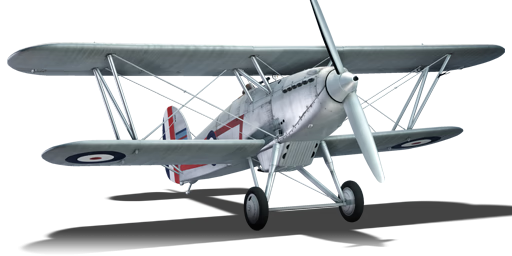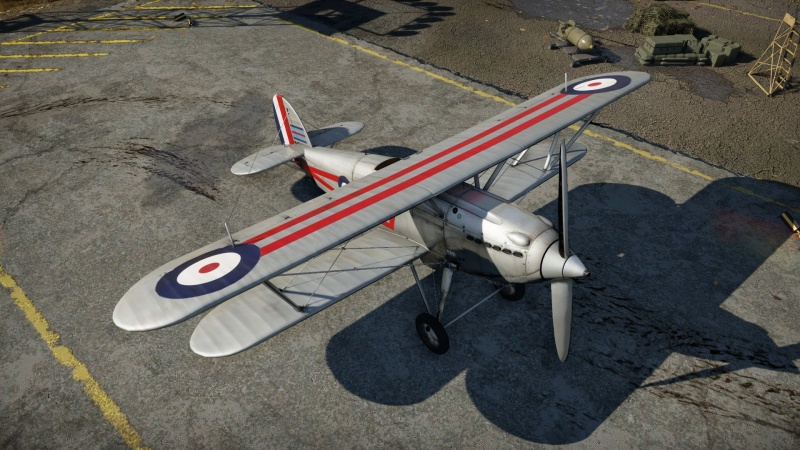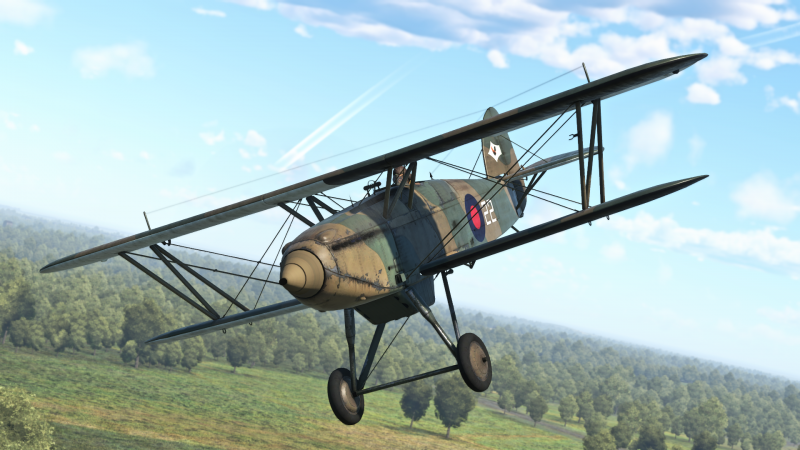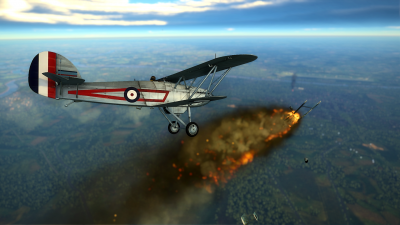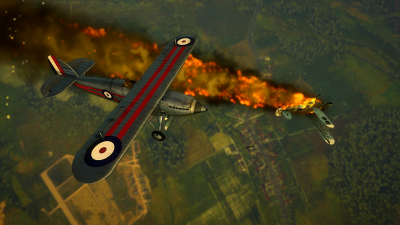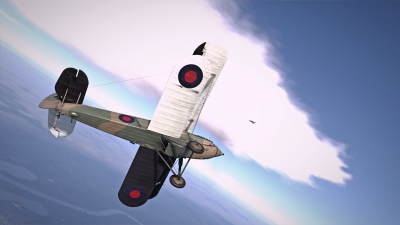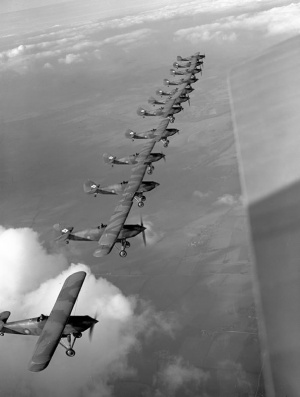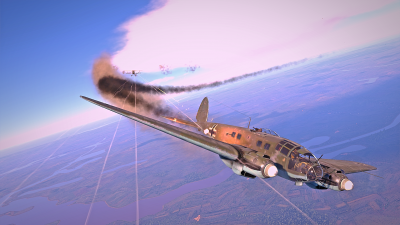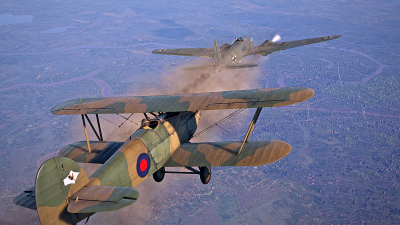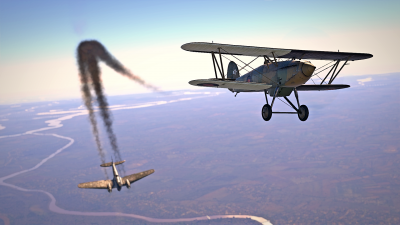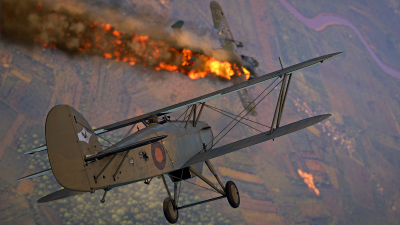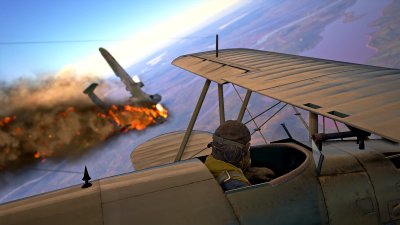Difference between revisions of "Fury Mk I"
Colok76286 (talk | contribs) (Edits) |
Colok76286 (talk | contribs) (Undo revision 194386 by U185747356 (talk)) |
||
| (31 intermediate revisions by 9 users not shown) | |||
| Line 9: | Line 9: | ||
{{Specs-Card | {{Specs-Card | ||
|code=fury_mk1 | |code=fury_mk1 | ||
| − | |images={{Specs-Card-Image|GarageImage_{{PAGENAME}}.jpg}} | + | |images={{Specs-Card-Image|GarageImage_{{PAGENAME}}.jpg|ArtImage_{{PAGENAME}}.png}} |
}} | }} | ||
== Description == | == Description == | ||
| − | <!-- ''In the description, the first part should be about the history of and the creation and combat usage of the aircraft, as well as its key features. In the second part, tell the reader about the aircraft in the game. Insert a screenshot of the vehicle, so that if the novice player does not remember the vehicle by name, he will immediately understand what kind of vehicle the article is talking about.'' --> | + | <!-- ''In the description, the first part should be about the history of and the creation and combat usage of the aircraft, as well as its key features. In the second part, tell the reader about the aircraft in the game. Insert a screenshot of the vehicle, so that if the novice player does not remember the vehicle by name, he will immediately understand what kind of vehicle the article is talking about.'' -->The first {{PAGENAME}} prototype was presented in 1927, with the first flight of a production model in March 1931 and entered service with the RAF in May of the same year, together with the [[Nimrod Mk I]] (a naval version of the Fury). The {{PAGENAME}} was in service with Yugoslavia, Iran, South Africa, as well as participated in the Spanish Civil War and World War II. A total of 117 {{PAGENAME}} fighters were produced. In 1937 the [[Fury Mk II]] was introduced with a more powerful engine. It replaced the {{PAGENAME}} in production and on airfields. |
| − | The | ||
| − | The Fury Mk I is one of the three reserve fighters in the British tree - the other two being the [[Nimrod Mk I]] | + | It has been in the game since the start of the Open Beta Test prior to Update 1.27. The Fury Mk I is one of the three reserve fighters in the British tree - the other two being the [[Nimrod Mk I]], as well as the [[Fury Mk II]]. In the game, the {{PAGENAME}} is a slow fighter with insufficient weapons and not the best rate of climb, but with quite great manoeuvrability. The turning speed is better than most other biplanes, which gives it an advantage, but during active manoeuvres, the speed is used up very quickly. Thus, after one full circle, it is impossible to stay at the same height, it is necessary to descend to maintain controllability of the aircraft. |
| − | |||
| − | |||
== General info == | == General info == | ||
| Line 24: | Line 21: | ||
{{Specs-Avia-Flight}} | {{Specs-Avia-Flight}} | ||
<!-- ''Describe how the aircraft behaves in the air. Speed, manoeuvrability, acceleration and allowable loads - these are the most important characteristics of the vehicle.'' --> | <!-- ''Describe how the aircraft behaves in the air. Speed, manoeuvrability, acceleration and allowable loads - these are the most important characteristics of the vehicle.'' --> | ||
| + | As a reserve plane, the Fury isn't a fast plane. It can't climb nor accelerate very well, but all the Fury variants can turn decently, though they tend to bleed energy easily. The modelled fixed pitch prop will mean not much power is around for climbing at the start of the match - a problem also currently shared with the later Gladiators. | ||
{| class="wikitable" style="text-align:center" width="70%" | {| class="wikitable" style="text-align:center" width="70%" | ||
| Line 112: | Line 110: | ||
<!-- ''Describe the offensive armament of the aircraft, if any. Describe how effective the cannons and machine guns are in a battle, and also what belts or drums are better to use. If there is no offensive weaponry, delete this subsection.'' --> | <!-- ''Describe the offensive armament of the aircraft, if any. Describe how effective the cannons and machine guns are in a battle, and also what belts or drums are better to use. If there is no offensive weaponry, delete this subsection.'' --> | ||
{{main|Vickers E (7.7 mm)}} | {{main|Vickers E (7.7 mm)}} | ||
| − | |||
The '''''{{PAGENAME}}''''' is armed with: | The '''''{{PAGENAME}}''''' is armed with: | ||
* 2 x 7.7 mm Vickers E machine guns, nose-mounted (600 rpg = 1,200 total) | * 2 x 7.7 mm Vickers E machine guns, nose-mounted (600 rpg = 1,200 total) | ||
| + | |||
| + | The {{PAGENAME}}'s armament, two 7.7 mm Vickers K machine guns, are suitable but inferior compared to other reserve fighters due to their small caliber and relatively slow muzzle velocity. This means the Fury can take a while (and a bit of ammo) to destroy targets it will face at its rank such as [[Bf 109 B-1/L|Bf 109 B-1]]s, [[CR.42]]s, [[I-15 WR|I-15s]] and even lightly armoured [[Ki-27 otsu|Ki-27s]] and [[A5M4|A5Ms]]. Keep in mind that unlike the current modelled Brownings as used on [[Gladiator Mk II|Gladiators]], these 7.7 mm guns won't do much damage unless you aim for the most vulnerable parts of your opponent's aircraft. | ||
| + | |||
| + | Use Universal or Stealth rounds with the Vickers K machine guns, but keep in mind that these 7.7 mm guns won't do much damage unless you aim for the most vulnerable parts of opposing aircraft. | ||
== Usage in battles == | == Usage in battles == | ||
<!-- ''Describe the tactics of playing in the aircraft, the features of using aircraft in a team and advice on tactics. Refrain from creating a "guide" - do not impose a single point of view, but instead, give the reader food for thought. Examine the most dangerous enemies and give recommendations on fighting them. If necessary, note the specifics of the game in different modes (AB, RB, SB).'' --> | <!-- ''Describe the tactics of playing in the aircraft, the features of using aircraft in a team and advice on tactics. Refrain from creating a "guide" - do not impose a single point of view, but instead, give the reader food for thought. Examine the most dangerous enemies and give recommendations on fighting them. If necessary, note the specifics of the game in different modes (AB, RB, SB).'' --> | ||
[[File:Fury Mk1 an trn 26 002.png|400px|thumb|right|A {{PAGENAME}} watching a He 51 B-1 go down in flames]] | [[File:Fury Mk1 an trn 26 002.png|400px|thumb|right|A {{PAGENAME}} watching a He 51 B-1 go down in flames]] | ||
| + | If you want to use the Fury, the best advice is to side climb a bit at the start of the match so you at least have some energy to work with. Plan manoeuvres ahead and go for easy targets such as inattentive planes and attackers destroying ground vehicles. Most of the problems with the plane are mitigated in Arcade Battles as traits like engine overheating and wing rip-offs are not modelled in that mode. | ||
| + | |||
The {{PAGENAME}} is a typical reserve aircraft in that it is an unremarkable plane. It is neither outstanding in speed, its manoeuvrability or even weapons loadout. Though contemporary aircraft may have a speed advantage, beefier weapons or even more manoeuvrability, the {{PAGENAME}} can still find its place on the battlefield in both in air battles and the ground attack game. | The {{PAGENAME}} is a typical reserve aircraft in that it is an unremarkable plane. It is neither outstanding in speed, its manoeuvrability or even weapons loadout. Though contemporary aircraft may have a speed advantage, beefier weapons or even more manoeuvrability, the {{PAGENAME}} can still find its place on the battlefield in both in air battles and the ground attack game. | ||
;Ground Attack | ;Ground Attack | ||
| + | |||
The {{PAGENAME}} has a crazy low stall-speed which allows it to circle anti-aircraft artillery or anti-aircraft vehicles easily. Though the plane's Vickers 7.7 mm machine guns are relatively weak, they can wreak havoc on the ground targets if enough bullets connect with their targets. If there are no enemy aircraft circling above the Mk I, then it can leisurely eliminate the ground targets, even tightly grouped vehicles. Even without access to bombs, the {{PAGENAME}} can be an effective ground attacker. | The {{PAGENAME}} has a crazy low stall-speed which allows it to circle anti-aircraft artillery or anti-aircraft vehicles easily. Though the plane's Vickers 7.7 mm machine guns are relatively weak, they can wreak havoc on the ground targets if enough bullets connect with their targets. If there are no enemy aircraft circling above the Mk I, then it can leisurely eliminate the ground targets, even tightly grouped vehicles. Even without access to bombs, the {{PAGENAME}} can be an effective ground attacker. | ||
;Air-to-air Attack | ;Air-to-air Attack | ||
| + | |||
| + | [[File:Fury Mk1 an trn 26 003.png|400px|thumb|right|A {{PAGENAME}} moving on to hit next target]] | ||
With many contemporary aircraft using faster firing machine guns, larger calibre guns or just more of them, it will take a skilful Fury pilot to balance or tip the scales. With 600 rounds of ammunition for each Vickers machine gun, there is a lot to work with; however, it is to the pilot's detriment to spray bullets everywhere. To make the most impact with the 7.7 mm rounds, the best chances to hit the enemy are when while in close. The longer the shot, the more likely bullets will either miss or harmlessly bounce off the target. Attacking close in between 100 and 300 m gives the best chances in critically damaging the enemy. Unless the pilot pulls off a pilot snipe and knocks out the pilot, chances are it may take a couple passes to inflict enough damage to send the target to the ground in flames. Close in attacks may offer the best opportunities to damage the enemy, but it can make for some hectic flying. | With many contemporary aircraft using faster firing machine guns, larger calibre guns or just more of them, it will take a skilful Fury pilot to balance or tip the scales. With 600 rounds of ammunition for each Vickers machine gun, there is a lot to work with; however, it is to the pilot's detriment to spray bullets everywhere. To make the most impact with the 7.7 mm rounds, the best chances to hit the enemy are when while in close. The longer the shot, the more likely bullets will either miss or harmlessly bounce off the target. Attacking close in between 100 and 300 m gives the best chances in critically damaging the enemy. Unless the pilot pulls off a pilot snipe and knocks out the pilot, chances are it may take a couple passes to inflict enough damage to send the target to the ground in flames. Close in attacks may offer the best opportunities to damage the enemy, but it can make for some hectic flying. | ||
The 7.7 mm bullets fired at aircraft fuselage do relatively little damage; therefore, it is crucial to target critical components such as the pilot, engines, oil coolers, and fuel tanks to eliminate the enemy effectively. Aircraft wings can also be susceptible to snapping if enough bullets perforate the skin and structure. | The 7.7 mm bullets fired at aircraft fuselage do relatively little damage; therefore, it is crucial to target critical components such as the pilot, engines, oil coolers, and fuel tanks to eliminate the enemy effectively. Aircraft wings can also be susceptible to snapping if enough bullets perforate the skin and structure. | ||
| − | One use for the {{PAGENAME}} is as an early interceptor aircraft against bombers. While | + | One use for the {{PAGENAME}} is as an early interceptor aircraft against bombers. While [[Do 17 (Family)|Do-17]], [[TBD-1]], [[SB 2M (Family)|SB 2M]], [[Ki-21 (Family)|Ki-21]], and [[F.222.2]] bombers have various defensive gunners, they are not impossible to shoot down with the Fury. The pilot does need to watch how they approach the bombers. Typically flying in from the front or the underside of the bombers allows for an unscathed approach. However, if you find that you must approach with a defensive position firing at you, make small adjustments to stay out of the line of fire and wait for the gunner to run out of ammunition before levelling off and taking a shot. Chances are you can knock out the gunner or even work on taking out the engines. A crippled bomber easily allows the more manoeuvrable biplane to make enough passes to finish the job. |
=== Manual Engine Control === | === Manual Engine Control === | ||
| Line 158: | Line 164: | ||
* Excellent vertical manoeuvrability | * Excellent vertical manoeuvrability | ||
* Incredibly low stall speed | * Incredibly low stall speed | ||
| − | * | + | * Engine never overheats, only on the really hot maps |
'''Cons:''' | '''Cons:''' | ||
| − | * Only has two rifle-calibre 7 mm | + | * Only has two rifle-calibre 7.7 mm machine guns, a challenge to damage enemy aircraft |
* Loses energy quite easily, mostly able to turn just once or twice | * Loses energy quite easily, mostly able to turn just once or twice | ||
* Not very beginner-friendly due to its flying characteristics | * Not very beginner-friendly due to its flying characteristics | ||
| − | * | + | * There is not WEP |
== History == | == History == | ||
<!-- ''Describe the history of the creation and combat usage of the aircraft in more detail than in the introduction. If the historical reference turns out to be too long, take it to a separate article, taking a link to the article about the vehicle and adding a block "/History" (example: <nowiki>https://wiki.warthunder.com/(Vehicle-name)/History</nowiki>) and add a link to it here using the <code>main</code> template. Be sure to reference text and sources by using <code><nowiki><ref></ref></nowiki></code>, as well as adding them at the end of the article with <code><nowiki><references /></nowiki></code>. This section may also include the vehicle's dev blog entry (if applicable) and the in-game encyclopedia description (under <code><nowiki>=== In-game description ===</nowiki></code>, also if applicable).'' --> | <!-- ''Describe the history of the creation and combat usage of the aircraft in more detail than in the introduction. If the historical reference turns out to be too long, take it to a separate article, taking a link to the article about the vehicle and adding a block "/History" (example: <nowiki>https://wiki.warthunder.com/(Vehicle-name)/History</nowiki>) and add a link to it here using the <code>main</code> template. Be sure to reference text and sources by using <code><nowiki><ref></ref></nowiki></code>, as well as adding them at the end of the article with <code><nowiki><references /></nowiki></code>. This section may also include the vehicle's dev blog entry (if applicable) and the in-game encyclopedia description (under <code><nowiki>=== In-game description ===</nowiki></code>, also if applicable).'' --> | ||
| − | [[File:Fury | + | [[File:Formation Fury Mk.1.jpg|thumb|Formation of {{PAGENAME}}]] |
| − | + | The first prototype of the Fury (initially named the Hawker ''Hornet'') was presented to the UK in 1927. In March 1931, after being renamed into the '''Hawker Fury''', the biplane made its maiden flight and entered service with the RAF in May of the same year. The Fury would serve in not only the Royal Air Force, but also with Yugoslavia, Iran, South Africa, and the Spanish, which they used during the Spanish Civil War. While the {{PAGENAME}} did not become a mainstream RAF fighter, Fury pilots were considered elite due to Fury-equipped squadrons such as No.1 squadron participations in gunnery and aerobatic competitions. A total of 117 {{PAGENAME}} fighters were produced. | |
| + | |||
| + | In 1937, the [[Fury Mk II]] was introduced with a more powerful engine. It replaced the {{PAGENAME}} in production and on airfields. | ||
| + | |||
| + | {{break}} | ||
| + | {{Navigation-Start|{{Annotation|Archive of the in-game description|An archive of the historical description of the vehicle that was presented in-game prior to Update 1.55 'Royal Armour'}}}} | ||
| + | {{Navigation-First-Simple-Line}} | ||
The Hawker Fury was a single engine, single-seat biplane of composite structure which first entered service in May 1931. The Fury was designed by H.G. Hawker Engineering Co. Ltd (Hawker Aircraft Ltd since 1933) under the direction of Sidney Camm. The Fury prototype made its first flight in March 1931 and after a successful test and evaluation period, entered production for service in Britain's Royal Air Force. However, the Fury was an expensive aircraft and, with Britain being in the grip of a financial depression, initially only enough aircraft were ordered to equip three squadrons; Nos 1, 25 and 43 Squadrons. | The Hawker Fury was a single engine, single-seat biplane of composite structure which first entered service in May 1931. The Fury was designed by H.G. Hawker Engineering Co. Ltd (Hawker Aircraft Ltd since 1933) under the direction of Sidney Camm. The Fury prototype made its first flight in March 1931 and after a successful test and evaluation period, entered production for service in Britain's Royal Air Force. However, the Fury was an expensive aircraft and, with Britain being in the grip of a financial depression, initially only enough aircraft were ordered to equip three squadrons; Nos 1, 25 and 43 Squadrons. | ||
| Line 182: | Line 194: | ||
A total of 117 Fury Mk.I fighters were produced, in five series. | A total of 117 Fury Mk.I fighters were produced, in five series. | ||
| + | {{Navigation-End}} | ||
== Media == | == Media == | ||
| Line 187: | Line 200: | ||
;Skins | ;Skins | ||
| + | |||
* [https://live.warthunder.com/feed/camouflages/?vehicle=fury_mk1 Skins and camouflages for the {{PAGENAME}} from live.warthunder.com.] | * [https://live.warthunder.com/feed/camouflages/?vehicle=fury_mk1 Skins and camouflages for the {{PAGENAME}} from live.warthunder.com.] | ||
;Images | ;Images | ||
| − | <gallery mode="packed"> | + | <gallery mode="packed-hover" heights="150"> |
File:Fury Mk1 an trn 26 005.png | File:Fury Mk1 an trn 26 005.png | ||
File:Fury Mk1 an trn 26 006.png | File:Fury Mk1 an trn 26 006.png | ||
| Line 197: | Line 211: | ||
File:Fury Mk1 an trn 26 009.png | File:Fury Mk1 an trn 26 009.png | ||
</gallery> | </gallery> | ||
| + | |||
| + | ;Videos | ||
| + | {{Youtube-gallery|xDiMJA-Sy1c|'''The Hawker Fury Mk.1''' - ''SirKittalot''|iIyGIQs8bSI|'''Hawker Fury Mk I''' - ''Wings''}} | ||
== See also == | == See also == | ||
| − | ''Links to the articles on the War Thunder Wiki that you think will be useful for the reader, for example:'' | + | <!-- ''Links to the articles on the War Thunder Wiki that you think will be useful for the reader, for example:'' |
* ''reference to the series of the aircraft;'' | * ''reference to the series of the aircraft;'' | ||
| − | * ''links to approximate analogues of other nations and research trees.'' | + | * ''links to approximate analogues of other nations and research trees.'' --> |
| + | |||
| + | * [[Fury Mk II]] | ||
| + | * [[Nimrod Mk I]] | ||
== External links == | == External links == | ||
''Paste links to sources and external resources, such as:'' | ''Paste links to sources and external resources, such as:'' | ||
| + | |||
* ''topic on the official game forum;'' | * ''topic on the official game forum;'' | ||
* ''other literature.'' | * ''other literature.'' | ||
Latest revision as of 07:44, 2 November 2024
| This page is about the British fighter Fury Mk I. For the other version, see Fury Mk II. For other uses, see Fury (Disambiguation). |
Contents
Description
The first Fury Mk I prototype was presented in 1927, with the first flight of a production model in March 1931 and entered service with the RAF in May of the same year, together with the Nimrod Mk I (a naval version of the Fury). The Fury Mk I was in service with Yugoslavia, Iran, South Africa, as well as participated in the Spanish Civil War and World War II. A total of 117 Fury Mk I fighters were produced. In 1937 the Fury Mk II was introduced with a more powerful engine. It replaced the Fury Mk I in production and on airfields.
It has been in the game since the start of the Open Beta Test prior to Update 1.27. The Fury Mk I is one of the three reserve fighters in the British tree - the other two being the Nimrod Mk I, as well as the Fury Mk II. In the game, the Fury Mk I is a slow fighter with insufficient weapons and not the best rate of climb, but with quite great manoeuvrability. The turning speed is better than most other biplanes, which gives it an advantage, but during active manoeuvres, the speed is used up very quickly. Thus, after one full circle, it is impossible to stay at the same height, it is necessary to descend to maintain controllability of the aircraft.
General info
Flight performance
As a reserve plane, the Fury isn't a fast plane. It can't climb nor accelerate very well, but all the Fury variants can turn decently, though they tend to bleed energy easily. The modelled fixed pitch prop will mean not much power is around for climbing at the start of the match - a problem also currently shared with the later Gladiators.
| Characteristics | Max Speed (km/h at 4,100 m) |
Max altitude (metres) |
Turn time (seconds) |
Rate of climb (metres/second) |
Take-off run (metres) | |||
|---|---|---|---|---|---|---|---|---|
| AB | RB | AB | RB | AB | RB | |||
| Stock | 385 | 371 | 8100 | 16.2 | 16.9 | 13.7 | 13.7 | 232 |
| Upgraded | 403 | 394 | 15.8 | 16.0 | 19.2 | 15.7 | ||
Details
| Features | ||||
|---|---|---|---|---|
| Combat flaps | Take-off flaps | Landing flaps | Air brakes | Arrestor gear |
| X | X | X | X | X |
| Limits | ||||||
|---|---|---|---|---|---|---|
| Wings (km/h) | Gear (km/h) | Flaps (km/h) | Max Static G | |||
| Combat | Take-off | Landing | + | - | ||
| 600 | 600 | N/A | N/A | N/A | ~11 | ~5 |
| Optimal velocities (km/h) | |||
|---|---|---|---|
| Ailerons | Rudder | Elevators | Radiator |
| < 260 | < 200 | < 300 | > 200 |
| Compressor (RB/SB) | ||
|---|---|---|
| Setting 1 | ||
| Optimal altitude | 100% Engine power | WEP Engine power |
| 3,705 m | 600 hp | N/A |
Survivability and armour
The Fury Mk I was an aircraft that was stripped of all which was unnecessary to enable it to be the lightest and fastest possible. Like many biplanes just before the start of World War II, the only protection afforded the pilot was the wood and canvas around him and the engine at the front of the aircraft. The best course of protection for this aircraft is to gain the element of surprise as it will not take much to damage critical components or knock out the pilot. All critical modules are concentrated in the forward fuselage area so attacks from the front or the side tend to do the most damage quickly.
- No armour protection
- Largely wood and canvas construction
- Self-sealing fuel tanks
Modifications and economy
Armaments
Offensive armament
The Fury Mk I is armed with:
- 2 x 7.7 mm Vickers E machine guns, nose-mounted (600 rpg = 1,200 total)
The Fury Mk I's armament, two 7.7 mm Vickers K machine guns, are suitable but inferior compared to other reserve fighters due to their small caliber and relatively slow muzzle velocity. This means the Fury can take a while (and a bit of ammo) to destroy targets it will face at its rank such as Bf 109 B-1s, CR.42s, I-15s and even lightly armoured Ki-27s and A5Ms. Keep in mind that unlike the current modelled Brownings as used on Gladiators, these 7.7 mm guns won't do much damage unless you aim for the most vulnerable parts of your opponent's aircraft.
Use Universal or Stealth rounds with the Vickers K machine guns, but keep in mind that these 7.7 mm guns won't do much damage unless you aim for the most vulnerable parts of opposing aircraft.
Usage in battles
If you want to use the Fury, the best advice is to side climb a bit at the start of the match so you at least have some energy to work with. Plan manoeuvres ahead and go for easy targets such as inattentive planes and attackers destroying ground vehicles. Most of the problems with the plane are mitigated in Arcade Battles as traits like engine overheating and wing rip-offs are not modelled in that mode.
The Fury Mk I is a typical reserve aircraft in that it is an unremarkable plane. It is neither outstanding in speed, its manoeuvrability or even weapons loadout. Though contemporary aircraft may have a speed advantage, beefier weapons or even more manoeuvrability, the Fury Mk I can still find its place on the battlefield in both in air battles and the ground attack game.
- Ground Attack
The Fury Mk I has a crazy low stall-speed which allows it to circle anti-aircraft artillery or anti-aircraft vehicles easily. Though the plane's Vickers 7.7 mm machine guns are relatively weak, they can wreak havoc on the ground targets if enough bullets connect with their targets. If there are no enemy aircraft circling above the Mk I, then it can leisurely eliminate the ground targets, even tightly grouped vehicles. Even without access to bombs, the Fury Mk I can be an effective ground attacker.
- Air-to-air Attack
With many contemporary aircraft using faster firing machine guns, larger calibre guns or just more of them, it will take a skilful Fury pilot to balance or tip the scales. With 600 rounds of ammunition for each Vickers machine gun, there is a lot to work with; however, it is to the pilot's detriment to spray bullets everywhere. To make the most impact with the 7.7 mm rounds, the best chances to hit the enemy are when while in close. The longer the shot, the more likely bullets will either miss or harmlessly bounce off the target. Attacking close in between 100 and 300 m gives the best chances in critically damaging the enemy. Unless the pilot pulls off a pilot snipe and knocks out the pilot, chances are it may take a couple passes to inflict enough damage to send the target to the ground in flames. Close in attacks may offer the best opportunities to damage the enemy, but it can make for some hectic flying.
The 7.7 mm bullets fired at aircraft fuselage do relatively little damage; therefore, it is crucial to target critical components such as the pilot, engines, oil coolers, and fuel tanks to eliminate the enemy effectively. Aircraft wings can also be susceptible to snapping if enough bullets perforate the skin and structure.
One use for the Fury Mk I is as an early interceptor aircraft against bombers. While Do-17, TBD-1, SB 2M, Ki-21, and F.222.2 bombers have various defensive gunners, they are not impossible to shoot down with the Fury. The pilot does need to watch how they approach the bombers. Typically flying in from the front or the underside of the bombers allows for an unscathed approach. However, if you find that you must approach with a defensive position firing at you, make small adjustments to stay out of the line of fire and wait for the gunner to run out of ammunition before levelling off and taking a shot. Chances are you can knock out the gunner or even work on taking out the engines. A crippled bomber easily allows the more manoeuvrable biplane to make enough passes to finish the job.
Manual Engine Control
| MEC elements | ||||||
|---|---|---|---|---|---|---|
| Mixer | Pitch | Radiator | Supercharger | Turbocharger | ||
| Oil | Water | Type | ||||
| Controllable | Not controllable Not auto controlled |
Not controllable Not auto controlled |
Controllable Not auto controlled |
Combined | Not controllable 1 gear |
Not controllable |
Pros and cons
Pros:
- Turns well for a biplane
- Excellent vertical manoeuvrability
- Incredibly low stall speed
- Engine never overheats, only on the really hot maps
Cons:
- Only has two rifle-calibre 7.7 mm machine guns, a challenge to damage enemy aircraft
- Loses energy quite easily, mostly able to turn just once or twice
- Not very beginner-friendly due to its flying characteristics
- There is not WEP
History
The first prototype of the Fury (initially named the Hawker Hornet) was presented to the UK in 1927. In March 1931, after being renamed into the Hawker Fury, the biplane made its maiden flight and entered service with the RAF in May of the same year. The Fury would serve in not only the Royal Air Force, but also with Yugoslavia, Iran, South Africa, and the Spanish, which they used during the Spanish Civil War. While the Fury Mk I did not become a mainstream RAF fighter, Fury pilots were considered elite due to Fury-equipped squadrons such as No.1 squadron participations in gunnery and aerobatic competitions. A total of 117 Fury Mk I fighters were produced.
In 1937, the Fury Mk II was introduced with a more powerful engine. It replaced the Fury Mk I in production and on airfields.
| Archive of the in-game description | |
|---|---|
|
The Hawker Fury was a single engine, single-seat biplane of composite structure which first entered service in May 1931. The Fury was designed by H.G. Hawker Engineering Co. Ltd (Hawker Aircraft Ltd since 1933) under the direction of Sidney Camm. The Fury prototype made its first flight in March 1931 and after a successful test and evaluation period, entered production for service in Britain's Royal Air Force. However, the Fury was an expensive aircraft and, with Britain being in the grip of a financial depression, initially only enough aircraft were ordered to equip three squadrons; Nos 1, 25 and 43 Squadrons. An elegant aircraft with streamlined fuselage contours, the Fury Mk.I was the first RAF fighter with a speed exceeding 322 km/h (200 mph). Most aircraft were equipped with a 525 hp liquid-cooled in-line twelve-cylinder Rolls-Royce Kestrel IIS engine and a wooden twin-bladed Watts propeller, although several alternative powerplants became available during the Fury's service life. The Fury's fuselage, wings, and tail had a metal framework and a fabric skin. The skin of the forward fuselage up to the cockpit and the engine cowling was made of duralumin sheets. Ailerons were fitted to the upper wing; nevertheless, due to their large area, they were very responsive and provided the aircraft with a high roll rate. The armament consisted of two synchronous 0.303 inch Vickers Mk.IV machine guns with 600 rounds per gun, mounted in front of the cockpit. Whilst the Fury was an excellent fighter when it first entered service, it did mark the end of an era as one of the last open cockpit, biplane fighters produced by Britain. Its fixed undercarriage, fabric skin and twin Vickers guns were reminiscent of fighters of the First World War, and when it was replaced in front line service with the RAF in 1939, it truly was a relic of a bygone era. A total of 117 Fury Mk.I fighters were produced, in five series. | |
Media
- Skins
- Images
- Videos
See also
External links
Paste links to sources and external resources, such as:
- topic on the official game forum;
- other literature.
| Hawker Aircraft Limited | |
|---|---|
| Biplane fighters | |
| Fury | Fury Mk I · Fury Mk II |
| Nimrod | Nimrod Mk I · Nimrod Mk II |
| Scout plane | Osprey Mk IV |
| Piston fighters | |
| Hurricane | Hurricane Mk I/L · Hurricane Mk.I/L FAA M · Sea Hurricane Mk IB · Sea Hurricane Mk IC · Hurricane Mk IIB/Trop · Hurricane Mk IV |
| Typhoon | Typhoon Mk Ia · Typhoon Mk Ib · Typhoon Mk Ib/L |
| Tempest | Tempest Mk V · Tempest Mk V (Vickers P) · Tempest Mk II |
| Fury | Sea Fury FB 11 |
| Jet fighters | |
| Hunter | Hunter F.1 · Hunter F.6 · Hunter FGA.9 |
| Sea Hawk | Sea Hawk FGA.6 |
| Harrier | Harrier GR.1 · Harrier GR.3 |
| Export | ▄Hurricane Mk I/L · ▂Hurricane Mk IIB · ◘Sea Fury FB 51 |
| ◘Sea Hawk Mk.50 · ◄Sea Hawk Mk.100 · ◘Hunter F.6 · ◌Hunter F.58 · J34 · AV-8A · AV-8C · ▄AV-8S | |
| Captured | ▀Tempest Mk V |
| See Also | Fokker |


